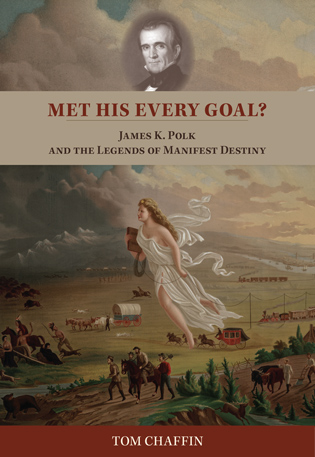Soon after his election as the 11th U.S. president, James K. Polk slapped his thigh and predicted what would be the “four great measures” of his administration: the acquisition of some or all of the Oregon Country, the acquisition of California, a reduction in tariffs, and the establishment of a permanent independent treasury.
In the four years of his presidency (1845-49), the Tennessee Democrat achieved all four goals. And those milestones—along with his purported enunciation of them—have come to define his presidency. Indeed, repeated ad infinitum in U.S. history textbooks, Polk’s bold listing of goals has become U.S. political history’s equivalent of Babe Ruth’s called home run of the 1932 World Series, in which the slugger allegedly gestured toward the outfield and, on the next pitch, slammed a home run.
But then again, as Tom Chaffin reveals in this lively tour de force of historiographic sleuthing, like Ruth’s alleged “called shot” of 1932, the “four measures” anecdote hangs by the thinnest of evidentiary threads. Indeed, not until the late 1880s, four decades after Polk’s presidency, did the story first appear in print.
In this eye-opening study, Tom Chaffin, author, historian, and former editor of the multi-volume series Correspondence of James K. Polk, dispatches the thigh-slap anecdote and other misconceptions associated with Polk. In the process, Chaffin demonstrates how the “four measures” story has skewed our understanding of the eleventh U.S. president. As president, Polk enlarged his nation’s area by a third—thus rendering it truly a coast-to-coast continental nation-state. Indeed, the anecdote does not record, and effectively obscures complex events, including notable failures—such as Polk’s botched effort to purchase Cuba, as well as his inability to shape the terms of California’s and the New Mexico territory’s admission into the Union. Cuba would never enter the federal Union; and those other tasks would be left for successor presidents. Indeed, debates over the future of slavery in the United States—debates accelerated by Polk’s territorial gains—eventually produced perhaps the central irony of his legacy: A president devoted to national unity further sectionalized the nation’s politics, widening geopolitical fractures among the states that soon led to civil war.
Engagingly written and lavishly illustrated, Met His Every Goal?—intended for general readers, students, and specialists—offers a primer on Polk and a revisionist view of much of the scholarship concerning him and his era. Drawing on published scholarship as well as contemporary documents—including heretofore unpublished materials—it presents a fresh portrait of an enigmatic autocrat. And in Chaffin’s examination of an oft-repeated anecdote long accepted as fact, readers witness a case study in how historians use primary sources to explore—and in some cases, explode—received conceptions of the past.
PRAISE & REVIEWS
“This book is foremost a wonderful study of how some questionable things become accepted facts, but it is also a call for a more nuanced evaluation of Polk¹s presidency free of the manifest destiny” that Bancroft manufactured for it. A short, lively read packed with numerous political cartoons and photos captioned in detail . . . highly recommended.” D. Butts, Gordon State College in Choice
“The list of things President Harry S. Truman, presidential architect Karl Rove and alt-rock band They Might Be Giants have in common is probably a short one. But all three agree on one thing: James K. Polk. . . .” John Bicknell, author of Religious Fervor, Westward Expansion, and the Presidential Election that Transformed the Nation reviews Met His Every Goal for Roll Call.
link
“With solid primary research and a dash of the detective, Tom Chaffin has done a masterful job of scrutinizing the origin and historical enshrinement of the legend that James K. Polk succinctly predicted the four great achievements of his administration. Met His Every Goal? is proof that history’s shorthand should always be questioned.”
—Walter R. Borneman, author of Polk: The Man Who Transformed the Presidency and America
“President James Polk’s reputation has been substantially influenced by a story that, early in 1845, he accurately predicted four principal achievements of his administration. Tom Chaffin, in a fascinating search for the truth—and based upon his unrivalled command of the relevant primary sources —demonstrates that the story of Polk’s foresight is almost certainly spurious. Chaffin thus clears the way for his convincing reassessment of Polk’s purposes and achievements.”
—William Dusinberre, author of Slavemaster President: The Double Career of James Polk
